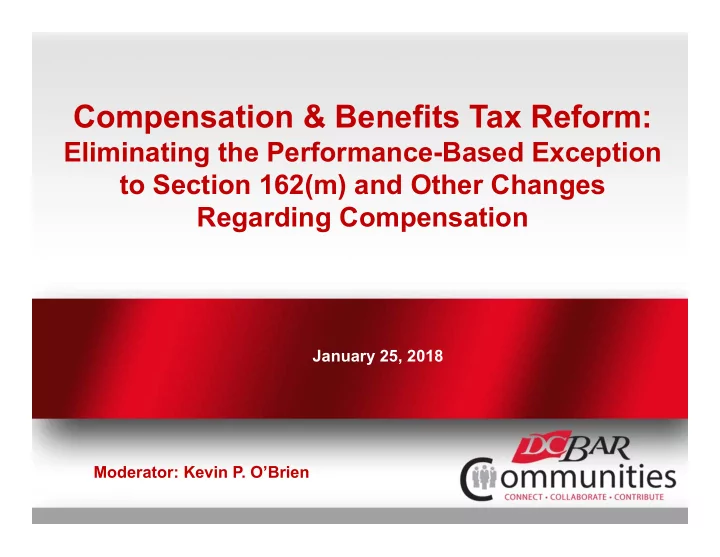

Compensation & Benefits Tax Reform: Eliminating the Performance-Based Exception to Section 162(m) and Other Changes Regarding Compensation January 25, 2018 Moderator: Kevin P. O’Brien
Tax Rate Changes Affect on Compensation 1. Individual Rates – 10%, 12%, 22%, 35%, and 37% • Supplemental Rates: Notice 1036 – 22% up to $1M, 37% over $1M 2. No AMT Repeal • 2018 AMT exemptions rises to $70,300 from ($54,300) for singles, and $109,400 (from $84,500) for married/joint filers • 2018 AMT phase-out: $500,000 for individuals (from $120,700) and $1,000,000 (from $160,900) for married couples • Less likely ISOs will trigger AMT 3. No Change in Capital Gains Rate (15% and 20%) • 15% threshold ($77,200 for joint filers, $38,600 for single) • 15% to 20% threshold ($475,000 joint filers, $425,800 single) 4. Excise tax on stock compensation – Inversions Section 4985 • Increased from 15% to 20% 5. Miscellaneous Itemized Deduction Repeal • Affects clawback repayments • No 162 or 165 deduction 6. Changes Not Enacted • No 409A repeal • No FIFO cost basis rule 2
Fringe Benefit and Retirement Plan Changes & Impact • Qualified Equity Grants – New IRC § 83(i) deferral election for options/RSUs • Deferral of income recognition for up to 5 years (or if earlier, on certain events including becoming transferable or IPO) • Deferral unavailable once employee becomes excluded (CEO or CFO and related individuals, 1% owner or top-4 highest paid officer (based on SEC disclosure rules if they had applied) in year or any prior 10 years) • Limited to eligible companies - stock not readily tradeable, written plan covers 80% of full-time employees who are granted options or RSUs • Amount included is still based on FMV at time of exercise-policy goal not valuation-based but about limiting need to liquidate holdings • Deferral election within 30 days after rights to shares are transferrable or vested • Deferral does not apply to Medicare, social security, taxes • Turns ISO into NQSO; does not apply to “early exercises” 3
Section 162(m) Summary • Expands companies covered • Expands officers covered • Covered employees FOREVER retain status • Repeals performance pay & commission exceptions • Transition relief applies to existing “written binding contracts” that are not “materially modified” – scope unclear 4
Expands Companies Covered • All ADR traded companies • Companies with publicly-traded debt • SEC 15(d) reporting • How are covered employees determined? • Example – ADR traded foreign parent 5
Expansion of “Covered Employee” • CFO added back to list • Covers individuals who are CEO or CFO (or acting as such) at any point during the year (not just last day) • Covered employees (starting in 2017) FOREVER retain status • Even after termination of employment • Perhaps even after company is acquired (reference to “predecessor” of taxpayer is not defined) • Captures pay that previously avoided the reach of Section 162(m) • Deferred compensation • Death benefits • Golden Parachutes 6
Transition Relief • Written binding contracts as of 11/2/2017 • That are not modified in material respects • Contract law issues • Unilateral contracts versus bilateral contract • Employers retained powers – negative discretion, plan amendment and termination, at will employment • Committee report example – raises questions • Significant issues • Outstanding grants • Nonqualified deferred compensation • Golden parachutes • 1993 transition rules • Covers unilateral contracts (Treas. Reg. § 1.162-27(h)(1), CCA 199926030) • At will employment does not negate transition • Extent of future accrual protection unclear (CCA 199926030) 7
Repeals Performance Pay Exceptions • Companies can move to non-performance based incentives, exercise discretion to increase payout • Companies free of the Section 162(m) compensation committee requirements • May not need shareholder re-approvals • Committee certification requirement eliminated – gives more flexibility as to timing of payments 8
Planning Opportunities • Installment payments favored: company may want to change payment to installments or encourage election of installments for future accruals • Company may want stock option exercises spaced out • Consulting arrangements • Qualified plan benefits exemption – QSERP • Non-taxable benefits ( e.g., retiree medical exempt) • Incorporated employee, partnership employs executive 9
Leveling the Playing Field…? • 21% excise tax on • Remuneration paid in excess of $1M, plus • Excess parachute payment by an “applicable exempt organization” to a “covered employee” • Paid when no SRF (457(f)(3)(B)) • Tax paid pro-rata if more than one payment source • No change to intermediate sanctions 10
Covered Employee • “Covered employee” is employee (including former employee) that • is one of the 5 highest compensated employees for the taxable year • was a covered employee for any preceding taxable year beginning after December 31, 2016 • Predecessor organization 11
Remuneration • Includes • Wages as defined for income tax withholding under 3401(a) • Other amounts required to be included in income under 457(f) • But excludes • Designated Roth contributions defined in 402A(c) • Remuneration paid to a licensed medical professional (including veterinarian) that is for the performance of medical or veterinary services by that professional • Remuneration not deductible under section 162(m) 12
Source of Remuneration • Applicable exempt organization • Related person or governmental entity • Controls, or is controlled by, the organization • Is controlled by one or more persons that control the organization, • Either a supported or supporting organization during the taxable year with respect to the organization (see 409(a)(3) and 509(f)(3)), or • Establishes, maintains, or makes contributions to a VEBA 13
Excess Parachute Payment • Excess of the present value of payments that are contingent on separation from service over 3 times the base amount • Excluded payments: • To or from a qualified plan • To or from a 403(b) annuity contract or 457(b) plan • To a licensed medical professional (veterinarian) to the extent the payment is for the performance of medical or veterinary services by the professional, or • To a non-HCE (section 414(q)) 14
Some Potential Responses 15
Recommend
More recommend